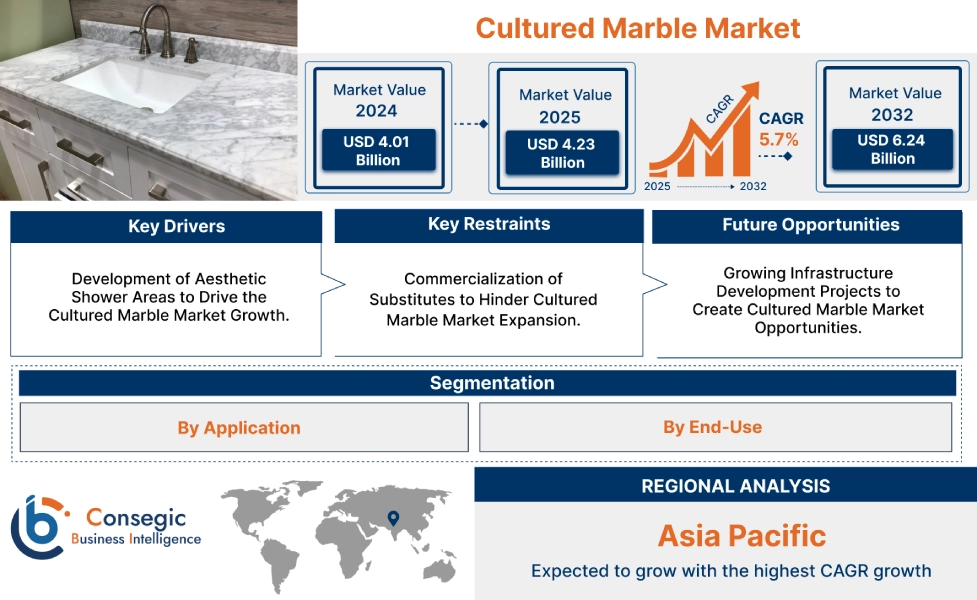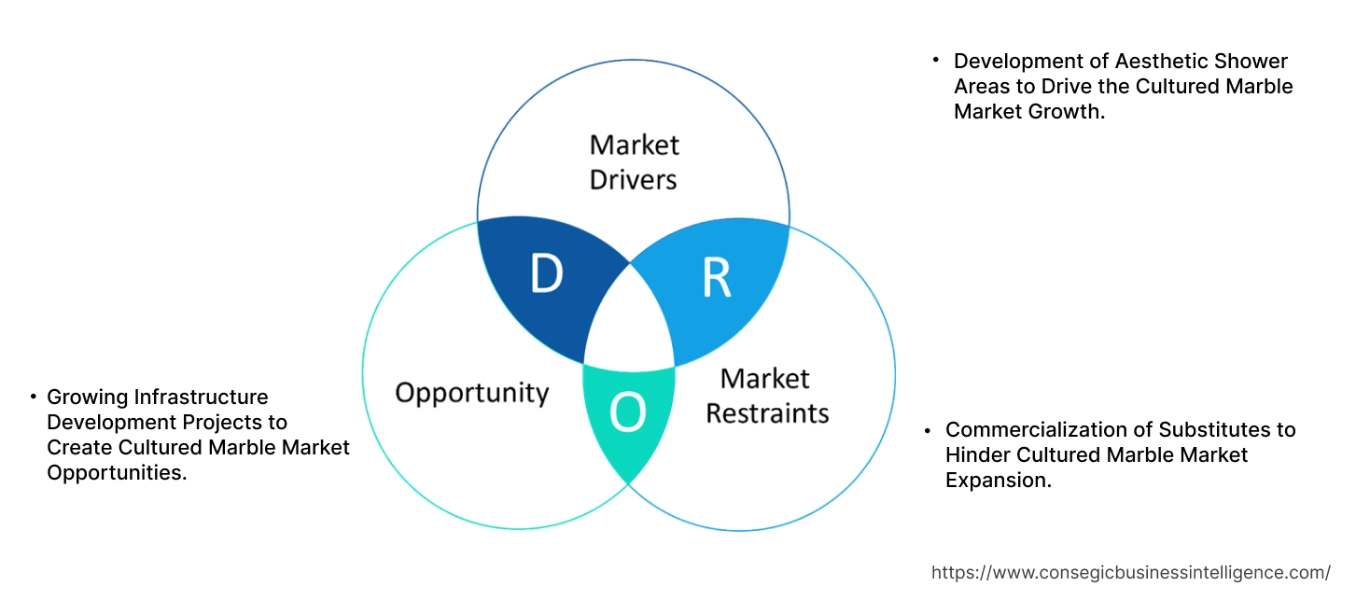Cultured Marble Market Size:
Cultured Marble market size is growing with a CAGR of 5.7% during the forecast period (2025-2032), and the market is projected to be valued at USD 6.24 Billion by 2032 from USD 4.01 Billion in 2024. Additionally, the market value for 2025 is attributed to USD 4.23 Billion.
Cultured Marble Market Scope & Overview:
Cultured marble is a man-made product that is engineered to mimic the luxurious appearance of natural marble, or granite, providing a more enhanced and more affordable alternative. It is primarily composed of crushed natural stone blended with a liquid polyester resin, which acts as a binder, and various pigments to achieve a wide array of colors and veining patterns. This mixture is then poured into molds, allowing for the development of seamless, custom-shaped products like countertops, vanity tops with integrated sinks, shower walls, and bathtubs, mainly with a durable, transparent gel coat applied to the surface. The manufacturing process allows for accurate control over the final product's dimensions, color consistency, and surface finish, resulting in a non-porous material that is highly resistant to stains, mildew, and chipping, making it a popular choice for bathrooms and kitchens in both residential and commercial settings due to its aesthetic appeal, durability, and ease of maintenance.
Cultured Marble Market Dynamics - (DRO) :
Key Drivers:
Development of Aesthetic Shower Areas to Drive the Cultured Marble Market Growth.
As homeowners increasingly look to transform their bathrooms into spa-like retreats, cultured marble provides an ideal solution, providing the luxurious appearance of natural stone at a more accessible price point. Its versatility in design allows for a wide array of colors, patterns, and seamless installations, eliminating grout lines and minimizing maintenance, which appeals to modern consumers prioritizing both beauty and practicality. This trend, coupled with the material's durability, stain resistance, and mold-inhibiting properties, makes these marbles an attractive choice for creating high-style, low-maintenance shower surrounds, and walls in both residential and commercial settings. Manufacturers are introducing novel shower lines that are providing various items made using these marbles.
For instance,
- In 2022, Wolf Home Products introduced its first shower line that is made using cultured marbles that mirror and detail of stone. These marble options match the bathroom visions of various homeowners.
Thus, the development of new aesthetic shower areas is driving the cultured marble market expansion.
Key Restraints:
Commercialization of Substitutes to Hinder Cultured Marble Market Expansion.
The cultured marble industry faces a significant restraint from the increasing commercialization of substitute materials, which mainly have comparable aesthetics, enhanced performance, or competitive pricing. Engineered quartz, for example, has gained substantial power due to its superior scratch and stain resistance, non-porous nature, and wide range of consistent patterns, directly competing with these marbles in popular applications like countertops and vanity tops. Furthermore, the advancements in large-format porcelain slabs and sintered stone provide ultra-durable, heat-resistant, and visually striking alternatives that mimic natural stone with even greater fidelity. As a result, the above-mentioned factors limit the cultured marble market demand.
Future Opportunities :
Growing Infrastructure Development Projects to Create Cultured Marble Market Opportunities.
As governments and private entities invest heavily in constructing new residential complexes, commercial buildings, hotels, hospitals, and public facilities, the requirement for durable, aesthetically pleasing, and cost-effective building materials like cultured marble naturally rises. Its versatility in applications such as countertops, vanities, flooring, and wall panels, coupled with its ability to mimic natural stone at a more accessible price point, positions this marble as an attractive choice for developers seeking to combine luxury finishes with practical benefits in these large-scale ventures of public and private infrastructure investments. The growing investment in infrastructure development influences the use of these marbles.
For instance,
- According to GGI Global Alliance AG, in 2025, Malaysian government allocated USD 20 billion to critical infrastructure improvements, creating potential for the market.
Thus, as per the market analysis, the rise in infrastructure development projects is influencing the cultured marble market opportunities.
Cultured Marble Market Segmental Analysis :
By Application:
Based on application, the market is categorized into countertops, shower walls, vanity tops, bathtubs, sinks, flooring, and others.
Trends in Application:
- The growing trend for aesthetically appealing countertops that align with the interior requirements of consumers is influencing the use of cultured marbles.
- The growing trend for low maintenance and easy to clean flooring are propelling the use of these marbles.
The countertops segment accounted for the largest market share in 2024.
- Countertops represent the largest and most prominent application for cultured marble, particularly in residential settings like kitchens and bathrooms.
- This is mainly due to its compelling combination of aesthetic versatility and practical advantages.
- The ability to mold cultured marble into seamless designs, including integrated sinks, eliminate grout lines, creating a sleek and hygienic surface that is both visually appealing, makes them a popular choice for vanity tops and kitchen work surfaces where durability and style are essential.
- The rise in investment for upgrading apartments is influencing the use of these marbles.
- For instance, in 2021, LIHC Investment Group and Silver Street Development Corp. secured USD 71 million to acquire Marble Hall Apartments in Tuckahoe, New York. They aim to upgrade 134 low-income units with new flooring, kitchens, and marble bathroom vanity tops.
- Thus, as per the market analysis, the aforementioned factors are influencing the growth of the segment.
The flooring segment is expected to grow at the fastest CAGR over the forecast period.
- Cultured marble flooring offers the aesthetic appeal of natural marble, replicating its elegant patterns and veining, but with enhanced properties.
- Being a non-porous material, it is resistant to stains, moisture, and mildew, making it an excellent choice for bathrooms, entryways, and other spaces prone to spills and humidity.
- Additionally, unlike natural stone that mainly requires regular sealing and thorough maintenance, cultured marble flooring is low-maintenance and easier to clean, providing a durable and cost-effective alternative for achieving a high-end look.
- Thus, owing to the aforementioned factors, the flooring segment is expected to grow at the fastest CAGR in the coming years.
By End Use:
Based on end use, the market is categorized into residential, commercial, and industrial.
Trends in the End Use:
- A key trend is the increasing adoption by homeowners for renovation projects and new housing, driven by a desire for enhanced aesthetics and durable material.
- A significant trend is the demand for enhanced durability and reliability of floorings in commercial settings.
The residential segment accounted for the largest cultured marble market share of 53.41% in 2024.
- In the residential sector, cultured marble finds widespread application, particularly in areas where both aesthetics and practicality are important.
- Its ability to mimic the luxurious appearance of natural marble, granite, or quartz, combined with its lower cost and enhanced durability, makes it a favored choice for homeowners.
- Primarily, it is used for bathroom vanity tops and integrated sinks, offering a seamless, easy-to-clean, and water-resistant surface that resists mold and mildew.
- It is also found in backsplashes in both kitchens and bathrooms, windowsills, and various decorative accents.
- The customizable nature of cultured marble, allowing for a wide array of colors, patterns, and shapes, further caters to individual homeowner preferences.
- The rise in the government’s support for home renovation is influencing the use of these marbles.
- For instance, in 2023, the Government of UK announced that Cosy Homes in Lancashire has been awarded USD 55.09 million for the second phase of the Home Upgrade Grant.
- Thus, as per the market analysis, the growth in the residential sector is influencing segment share.
The commercial segment is expected to grow at the fastest CAGR over the forecast period.
- The commercial sector is a rapidly expanding end-use segment for cultured marble, driven by its blend of aesthetic appeal, durability, and cost-effectiveness compared to natural stone.
- In commercial settings such as hospitality venues, offices and corporate bathrooms, retail establishments, and even healthcare and educational facilities, cultured marble is increasingly favored for applications like countertops, vanity tops with integrated sinks, shower surrounds, wall panels, and decorative accents in lobbies and reception areas.
- Its non-porous surface makes it highly resistant to stains, moisture, bacteria, and various construction chemicals making it ideal for high-traffic environments that require stringent hygiene and easy maintenance.
- Hence, owing to the above-mentioned analysis, the commercial segment is expected to grow at the fastest rate over the future years, creating cultured marble market trends.
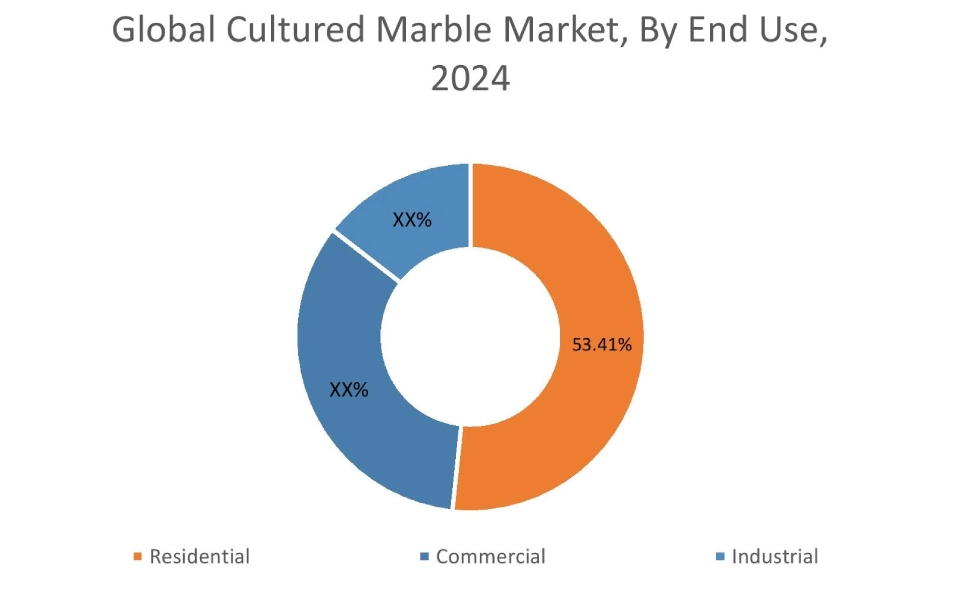
Regional Analysis:
The regional segment includes North America, Europe, Asia Pacific, the Middle East and Africa, and Latin America.
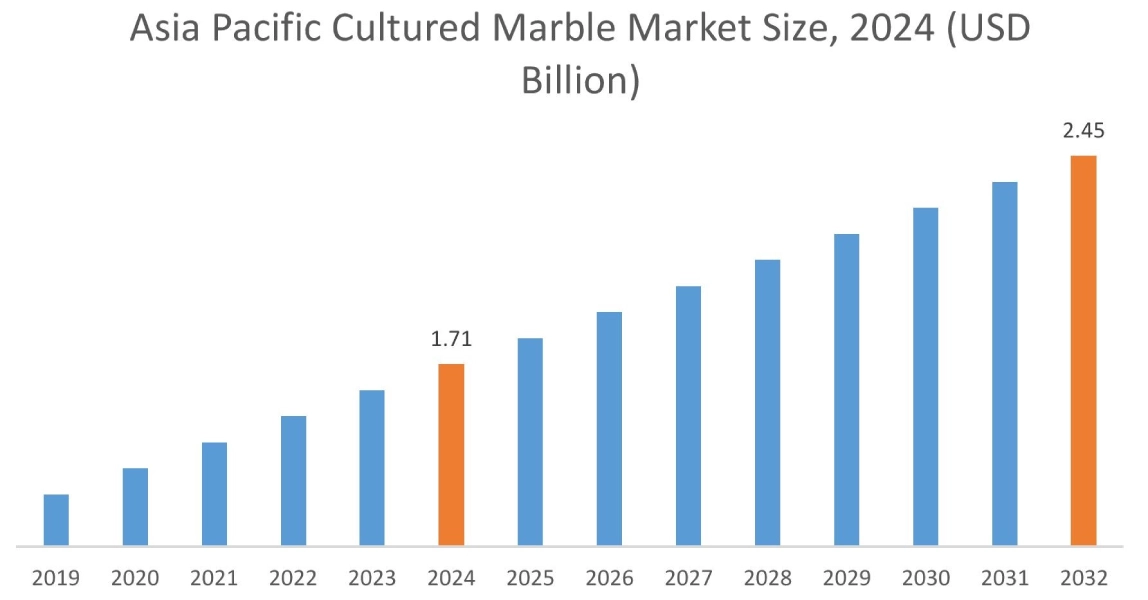
In 2024, Asia Pacific accounted for the highest cultured marble market share at 42.64% and was valued at USD 1.71 Billion and is expected to reach USD 2.45 Billion in 2032. In Asia Pacific, China accounted for a market share of 38.76% during the base year of 2024. The Asia Pacific region is experiencing a significant surge in residential construction, influenced by rapid urbanization, a growing middle class, and increasing disposable incomes, mainly in countries such as China and India. This growth in housing development is a primary catalyst for the escalating use of cultured marble, which offers an attractive and cost-effective alternative to natural stone for applications such as countertops, vanities, bathtubs, and flooring. The rise in residential sales is influencing the use of these marbles.
For instance,
- The data by National Bureau of Statistics of China, in 2022, states that the residential area for sale in China increased by 18.4%.
Thus, as per the cultured marble market analysis, the rise in sales in the residential sector creates a strong upward trajectory for the Asia Pacific market, positioning it as a key region for players.
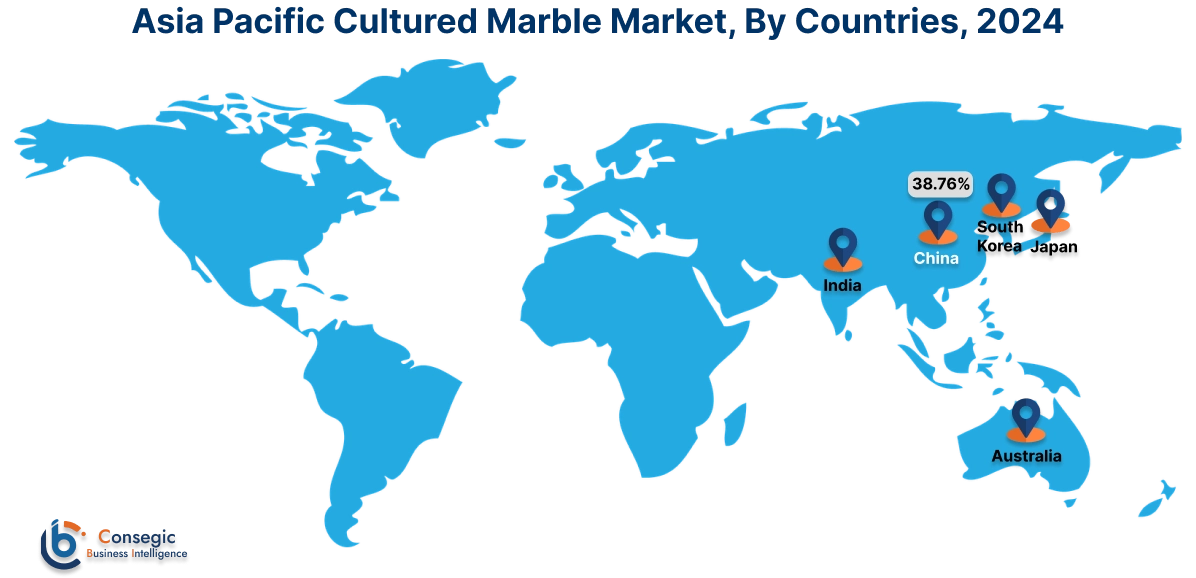
In Europe, the industry is experiencing the fastest growth with a CAGR of 7.6% over the forecast period. The rise in infrastructure projects, coupled with a growing emphasis on aesthetically pleasing yet durable and cost-effective building materials, is directly fueling the demand for cultured marble across the region. These marbles are increasingly being utilized in non-residential applications such as hotels, corporate offices, public restrooms, and even in some flooring and wall panel applications within commercial and institutional buildings. As European governments and private firms continue to invest in both new infrastructure and the renovation of existing facilities, the versatility and practical benefits of these marble make it a key material in meeting the evolving demands for high-quality and long-lasting finishes in the region's expanding construction landscape. Thus, the aforementioned factors are driving the cultured marble market demand in this region.
In North America, cultured marble finds significant application in countertops, particularly within the residential sector for both new home construction and renovation projects, as well as in commercial settings like hospitality, healthcare, and retail. Its popularity is influenced because of its ability to mimic the luxurious appearance of natural marble at a more affordable price point, coupled with its excellent durability, resistance to stains, moisture, and chips, and ease of maintenance due to its non-porous surface. Thus, as per the cultured marble market analysis, the rise in the use of countertops made from these materials is propelling the growth of the market in this region.
One of the Latin American market trends is the region's focus on construction and development. Latin America’s ongoing development influences the use of cultured marbles in flooring because of its ability to offer a luxurious appearance similar to natural stone, but with practical advantages such as superior durability, ease of maintenance, and resistance to stains and moisture. The seamless installation of these marble flooring also minimizes grout lines, contributing to a sleek and polished surface that appeals to both residential and non-residential projects in Latin America, where there's a growing demand for cost-effective yet aesthetically pleasing building materials in new construction and renovation. Thus, these aforementioned factors are contributing to the cultured marble market growth in this region.
The Middle East and Africa (MEA) region is experiencing a significant surge in the use of cultured marble for bathroom applications, driven primarily by growth in residential and commercial construction, particularly in luxury real estate and hospitality sectors. The marble's non-porous surface makes it highly resistant to stains, moisture, and bacteria, making it ideal for vanity tops, integrated sinks, seamless shower surrounds, and bathtubs, where hygiene and easy maintenance are important. Thus, the aforementioned factors are influencing the cultured marble market trends in this region.
Top Key Players and Market Share Insights:
The Global Cultured Marble Market is highly competitive with major players providing products to the national and international markets. Key players are adopting several strategies in research and development (R&D) and product innovation to hold a strong position in the global Cultured Marble market. Key players in the Cultured Marble industry include
- Cultured Marble Products (U.S.)
- Kerrico Corporation (U.S.)
- Wolf Home Products (U.S.)
- Patrician Marble Company (U.S.)
- YOSHIMOTO SANGYO Co., Ltd. (Japan)
- Marblecraft Company, Inc. (U.S.)
- Leslie Marble (U.S.)
- Patrician Marble Company (U.S.)
- Virginia Marble (U.S.)
- Hangzhou Nabel China Co., Ltd (China)
Cultured Marble Market Report Insights :
| Report Attributes | Report Details |
| Study Timeline | 2019-2032 |
| Market Size in 2032 | USD 6.24 Billion |
| CAGR (2025-2032) | 5.7% |
| By Application |
|
| By End Use |
|
| By Region |
|
| Key Players |
|
| North America | U.S. Canada Mexico |
| Europe | U.K. Germany France Spain Italy Russia Benelux Rest of Europe |
| APAC | China South Korea Japan India Australia ASEAN Rest of Asia-Pacific |
| Middle East and Africa | GCC Turkey South Africa Rest of MEA |
| LATAM | Brazil Argentina Chile Rest of LATAM |
| Report Coverage |
|
Key Questions Answered in the Report
How big is the Cultured Marble market? +
In 2024, the Cultured Marble market is USD 4.01 Billion.
Which is the fastest-growing region in the Cultured Marble market? +
Europe is the fastest-growing region in the Cultured Marble market.
What specific segmentation details are covered in the Cultured Marble market? +
By Application and End Use segmentation details are covered in the Cultured Marble market.
Who are the major players in the Cultured Marble market? +
Cultured Marble Products (U.S.), Kerrico Corporation (U.S.), Wolf Home Products (U.S.) are some of the major players in the market.
